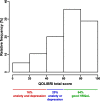Quality of life up to 10 years after traumatic brain injury: a cross-sectional analysis
- PMID: 32498679
- PMCID: PMC7271485
- DOI: 10.1186/s12955-020-01391-3
Quality of life up to 10 years after traumatic brain injury: a cross-sectional analysis
Abstract
Background: Traumatic brain injury (TBI) is the leading cause of death and disability among children and young adults in industrialized countries, but strikingly little is known how patients cope with the long-term consequences of TBI. Thus, the aim of the current study was to elucidate health-related quality of life (HRQoL) and outcome predictors in chronic TBI adults.
Methods: In this cross-sectional study, 439 former patients were invited to report HRQoL up to 10 years after mild, moderate or severe TBI using the QOLIBRI (Quality of Life after Brain Injury) questionnaire. The QOLIBRI total score has a maximum score of 100. A score below 60 indicates an unfavorable outcome with an increased risk of an affective and/or anxiety disorder. Results were correlated with demographics and basic characteristics received from medical records (TBI severity, etiology, age at TBI, age at survey, time elapsed since TBI, and sex) using regression models. Differences were considered significant at p < 0.05.
Results: From the 439 invited patients, 135 out of 150 in principle eligible patients (90%) completed the questionnaire; 76% were male, and most patients experienced severe TBI due to a traffic-related accident (49%) or a fall (44%). The mean QOLIBRI total score was 65.5 (± 22.6), indicating good HRQoL. Factors for higher level of satisfaction (p = 0.03; adjusted R2 = 0.1) were autonomy in daily life (p = 0.03; adjusted R2 = 0.09) and cognition (p = 0.05; adjusted R2 = 0.05). HRQoL was weakly correlated with initial TBI severity (p = 0.04; adjusted R2 = 0.02). 36% of patients reported unfavorable HRQoL with increased risk of one (20%) or two (16%) psychiatric disorders.
Conclusions: The majority of chronic TBI patients reported good HRQoL and the initial TBI severity is a slight contributor but not a strong predictor of HRQoL. Autonomy and cognition are decisive factors for satisfied outcome and should be clearly addressed in neurorehabilitation. One third of patients, however, suffer from unsatisfactory outcome with psychiatric sequelae. Thus, an early neuropsychiatric assessment after TBI is necessary and need to be installed in future TBI guidelines.
Keywords: Adaptation and resilience; Anxiety; Autonomy and cognition as decisive outcome factors for satisfaction; Depressive disorder; Health-related quality of life after brain injury; Long-term outcome; Psychiatric disorders after brain injury; QOLIBRI; TBI guidelines; Traumatic brain injury.
Conflict of interest statement
Nothing to declare.
Figures




Similar articles
-
Prospective evaluation of the Quality of Life after Brain Injury (QOLIBRI) score: minor differences in patients with major versus no or mild traumatic brain injury at one-year follow up.Health Qual Life Outcomes. 2018 Jul 9;16(1):136. doi: 10.1186/s12955-018-0966-z. Health Qual Life Outcomes. 2018. PMID: 29986710 Free PMC article.
-
Quality of life after traumatic brain injury: a cross-sectional analysis uncovers age- and sex-related differences over the adult life span.Geroscience. 2021 Feb;43(1):263-278. doi: 10.1007/s11357-020-00273-2. Epub 2020 Oct 17. Geroscience. 2021. PMID: 33070278 Free PMC article.
-
The Norwegian version of the QOLIBRI - a study of metric properties based on a 12 month follow-up of persons with traumatic brain injury.Health Qual Life Outcomes. 2017 Jan 19;15(1):14. doi: 10.1186/s12955-017-0589-9. Health Qual Life Outcomes. 2017. PMID: 28103876 Free PMC article.
-
Assessment of health-related quality of life in persons after traumatic brain injury--development of the Qolibri, a specific measure.Acta Neurochir Suppl. 2005;93:43-9. doi: 10.1007/3-211-27577-0_6. Acta Neurochir Suppl. 2005. PMID: 15986726 Review.
-
[Mild traumatic brain injury and postconcussive syndrome: a re-emergent questioning].Encephale. 2012 Sep;38(4):329-35. doi: 10.1016/j.encep.2011.07.003. Epub 2011 Aug 31. Encephale. 2012. PMID: 22980474 Review. French.
Cited by
-
Social participation and health-related quality of life before and during the second wave of the Covid-19 pandemic in individuals with traumatic brain injury: A follow-up exploratory correlational study.J Rehabil Med. 2023 Jun 30;55:jrm4530. doi: 10.2340/jrm.v55.4350. J Rehabil Med. 2023. PMID: 37389579 Free PMC article.
-
Frontal Pole Neuromodulation for Impulsivity and Suicidality in Veterans With Mild Traumatic Brain Injury and Common Co-Occurring Mental Health Conditions: Protocol for a Pilot Randomized Controlled Trial.JMIR Res Protoc. 2024 Dec 13;13:e58206. doi: 10.2196/58206. JMIR Res Protoc. 2024. PMID: 39671573 Free PMC article.
-
Performance of the Rivermead Post-Concussion Questionnaire in a sample of people with traumatic brain injury living in Italy.Eur J Phys Rehabil Med. 2024 Aug;60(4):594-596. doi: 10.23736/S1973-9087.24.08127-9. Epub 2024 Jul 12. Eur J Phys Rehabil Med. 2024. PMID: 38994557 Free PMC article. No abstract available.
-
Longitudinal Analyses of the Reciprocity of Depression and Anxiety after Traumatic Brain Injury and Its Clinical Implications.J Clin Med. 2021 Nov 28;10(23):5597. doi: 10.3390/jcm10235597. J Clin Med. 2021. PMID: 34884299 Free PMC article.
-
The Effects of Early Life History of TBI on the Progression of Normal Brain Aging with Implications for Increased Dementia Risk.Adv Neurobiol. 2024;42:119-143. doi: 10.1007/978-3-031-69832-3_6. Adv Neurobiol. 2024. PMID: 39432040 Review.
References
-
- Maas AIR, Menon DK, Adelson PD, et al. Traumatic brain injury: integrated approaches to improve prevention, clinical care, and research. Lancet Neurol. 2017;16:987–1048. - PubMed
-
- Corrigan JD, Selassie AW, Orman JA. The epidemiology of traumatic brain injury. J Head Trauma Rehabil. 2010;25:72–80. - PubMed
-
- Rutland-Brown W, Langlois JA, Thomas KE, Xi YL. Incidence of traumatic brain injury in the United States, 2003. J Head Trauma Rehabil. 2006;21:544–548. - PubMed
-
- Georges A, Booker JG. Traumatic brain injury. StatPearls. Treasure Island (FL): StatPearls Publishing LLC; 2018.
MeSH terms
LinkOut - more resources
Full Text Sources
Medical

